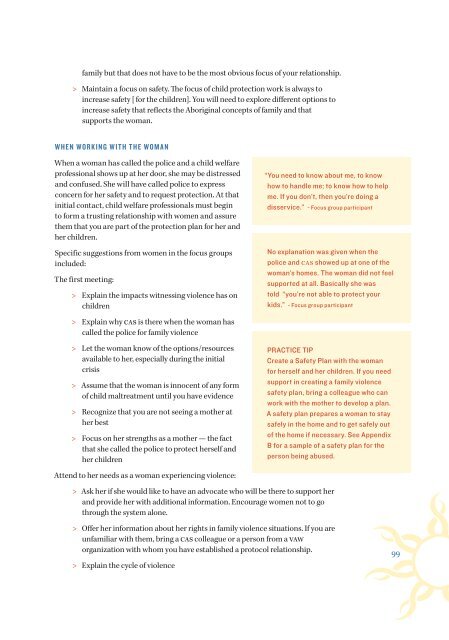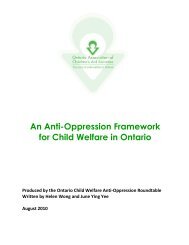English - Ontario Association of Children's Aid Societies
English - Ontario Association of Children's Aid Societies
English - Ontario Association of Children's Aid Societies
Create successful ePaper yourself
Turn your PDF publications into a flip-book with our unique Google optimized e-Paper software.
family but that does not have to be the most obvious focus <strong>of</strong> your relationship.<br />
> > Maintain a focus on safety. The focus <strong>of</strong> child protection work is always to<br />
increase safety [ for the children]. You will need to explore different options to<br />
increase safety that reflects the Aboriginal concepts <strong>of</strong> family and that<br />
supports the woman.<br />
WHEN WORKING WITH THE WOMAN<br />
When a woman has called the police and a child welfare<br />
pr<strong>of</strong>essional shows up at her door, she may be distressed<br />
and confused. She will have called police to express<br />
concern for her safety and to request protection. At that<br />
initial contact, child welfare pr<strong>of</strong>essionals must begin<br />
to form a trusting relationship with women and assure<br />
them that you are part <strong>of</strong> the protection plan for her and<br />
her children.<br />
“You need to know about me, to know<br />
how to handle me; to know how to help<br />
me. If you don’t, then you’re doing a<br />
disservice.” - Focus group participant<br />
Specific suggestions from women in the focus groups<br />
included:<br />
The first meeting:<br />
> > Explain the impacts witnessing violence has on<br />
children<br />
> > Explain why CAS is there when the woman has<br />
called the police for family violence<br />
> > Let the woman know <strong>of</strong> the options/resources<br />
available to her, especially during the initial<br />
crisis<br />
> > Assume that the woman is innocent <strong>of</strong> any form<br />
<strong>of</strong> child maltreatment until you have evidence<br />
> > Recognize that you are not seeing a mother at<br />
her best<br />
> > Focus on her strengths as a mother — the fact<br />
that she called the police to protect herself and<br />
her children<br />
Attend to her needs as a woman experiencing violence:<br />
> > Ask her if she would like to have an advocate who will be there to support her<br />
and provide her with additional information. Encourage women not to go<br />
through the system alone.<br />
> > Offer her information about her rights in family violence situations. If you are<br />
unfamiliar with them, bring a CAS colleague or a person from a VAW<br />
organization with whom you have established a protocol relationship.<br />
> > Explain the cycle <strong>of</strong> violence<br />
No explanation was given when the<br />
police and CAS showed up at one <strong>of</strong> the<br />
woman’s homes. The woman did not feel<br />
supported at all. Basically she was<br />
told “you’re not able to protect your<br />
kids.” - Focus group participant<br />
PRACTICE TIP<br />
Create a Safety Plan with the woman<br />
for herself and her children. If you need<br />
support in creating a family violence<br />
safety plan, bring a colleague who can<br />
work with the mother to develop a plan.<br />
A safety plan prepares a woman to stay<br />
safely in the home and to get safely out<br />
<strong>of</strong> the home if necessary. See Appendix<br />
B for a sample <strong>of</strong> a safety plan for the<br />
person being abused.<br />
99

















